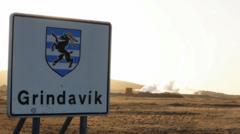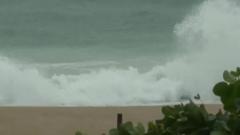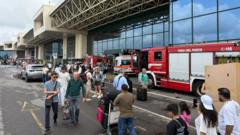The Reykjanes Peninsula in South-West Iceland has erupted, as announced by Iceland's Meteorological Office. The eruption began at approximately 09:45 local time (10:45 BST) just north of the town of Grindavík. Within the first hour, the fissure had expanded to 700 meters (2,296 feet) and continues to widen. This volcanic activity was preceded by hundreds of earthquakes in the region, with seismic activity noted around 06:30 local time.
Prior to the eruption, both Grindavík and the famous tourist destination Blue Lagoon were evacuated as a precautionary measure. Road access to and from Grindavík has been suspended, but airport operations remain unaffected as of the latest updates. By 11:00 local time, the Icelandic Meteorological Office reported the fissure had lengthened further south, alongside the emergence of a new crack.
Despite the evacuation orders, reports indicated that some individuals chose to stay behind. Local authorities, including Police Chief Úlfar Lúðvíksson, mentioned that only about 40 homes in the area are currently occupied, following earlier evacuations that had already displaced most of the town's approximately 4,000 residents. Significant evacuation took place November 2023 due to prior eruptions that continued through the winter months.
As the magma tunnel beneath the crater now measures approximately 11 kilometers (6.8 miles), the longest recorded since November 2023, officials stress the importance of fleeing the area. The direction of prevailing winds may cause volcanic gas to drift northeast towards the capital, warranting additional warnings. The Reykjanes Peninsula has witnessed a series of eruptions since 2021, marking a historic return of volcanic activity last seen 800 years ago, with Iceland being home to 33 active volcanic systems situated atop the Mid-Atlantic Ridge, a major tectonic plate boundary.
Prior to the eruption, both Grindavík and the famous tourist destination Blue Lagoon were evacuated as a precautionary measure. Road access to and from Grindavík has been suspended, but airport operations remain unaffected as of the latest updates. By 11:00 local time, the Icelandic Meteorological Office reported the fissure had lengthened further south, alongside the emergence of a new crack.
Despite the evacuation orders, reports indicated that some individuals chose to stay behind. Local authorities, including Police Chief Úlfar Lúðvíksson, mentioned that only about 40 homes in the area are currently occupied, following earlier evacuations that had already displaced most of the town's approximately 4,000 residents. Significant evacuation took place November 2023 due to prior eruptions that continued through the winter months.
As the magma tunnel beneath the crater now measures approximately 11 kilometers (6.8 miles), the longest recorded since November 2023, officials stress the importance of fleeing the area. The direction of prevailing winds may cause volcanic gas to drift northeast towards the capital, warranting additional warnings. The Reykjanes Peninsula has witnessed a series of eruptions since 2021, marking a historic return of volcanic activity last seen 800 years ago, with Iceland being home to 33 active volcanic systems situated atop the Mid-Atlantic Ridge, a major tectonic plate boundary.


















